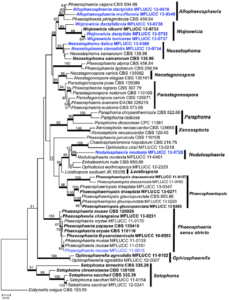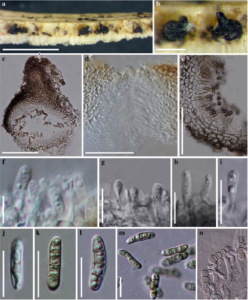Neosetophoma clematidis Wijayawardene, Camporesi & K.D. Hyde.
Index Fungorum number: IF 505909, Faces of Fungi number: FoF 00419; Fig. 2
Etymology – Named after host on which it was first collected
Holotypus – MFLU 14–0746
Saprobic on branch of Clematis vitalba. Sexual morph Undetermined. Asexual morph Conidiomata 425 – 475 μm diam., 220 – 270 μm high, pycnidial, superficial, black, gregarious, unilocular, but occasionally multi-locular, with a papillate ostiole. Pycnidial wall 30 – 55 μm wide, thick at outer layer brown to dark brown, with 4 – 10 cell layers, inner layer hyaline, 3 – 5 cell layers, cells of textura angularis. Conidiophores reduced to conidiogenous cells. Conidiogenous cells 3 – 5 × 1 – 3 μm, simple, smooth, hyaline, integrated, enteroblastic, phialidic. Conidia 11 – 15 × 2 – 4 μm (x̄ = 12.71 × 2.95 μm, n = 20), slightly brown, straight to curve, continuous, with truncate base, with obtuse apex, 3 – euseptate, often slightly narrower in the middle, smooth-walled, guttulate.
Culture characters – on PDA white from above and greyish white from reverse, cottony, circular, zonate, slow growing, attaining a diam. of 1.5 cm in 7 days at 18 °C.
Material examined – Italy, Province of Forlì-Cesena, Pietrapazza, Bagno di Romagna, on dead branch of Clematis vitalba L. (Ranunculaceae), 20 January 2013, E. Camporesi, IT1027 (MFLU 14–0746, holotype); ibid., GUHC 7204, isotype), ex-type living culture, MFLUCC 13–0734, GUCC 20. GenBank ITS: KP744450; LSU: KP684153; SSU: KP684154.
Notes – The phylogenetic tree showed that this species belongs to Neosetophoma and is a different species to N. italica and N. samarorum (Fig. 1).

Fig. 1 Phylogram generated from Maximum likelihood (RAxML) analysis based on combined LSU, SSU and ITS sequence data of Phaeosphaeriaceae. Maximum likelihood bootstrap support values greater than 50 % are indicated above or below the nodes, and branches with Bayesian posterior probabilities greater than 0.95 are given in bold. The ex-types (reference strains) are in bold; the new isolates are in blue. The tree is rooted with Didymella exigua CBS 183.55.

Fig. 2 Neosetophoma clematidis (holotype) a, b Conidiomata on the host plant c Cross section of conidioma d, e Pycnidium wall f – i Different stages of conidiogeny j-m Conidia n Germinating conidia. Scale bars: a = 500 μm, b = 200 μm, c = 100 μm, d – e = 50 μm, f = 5 μm, g – m = 10 μm.
